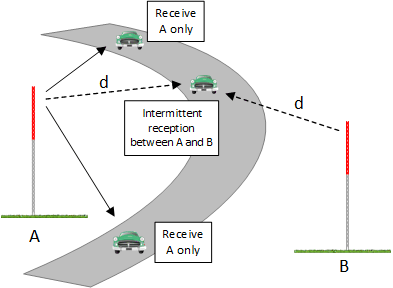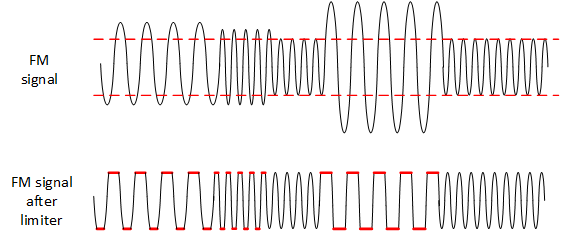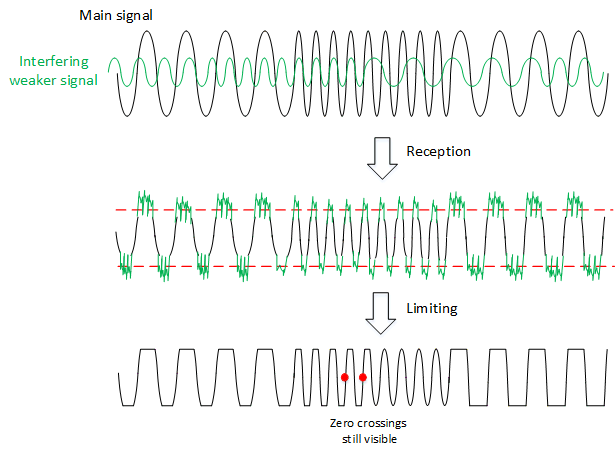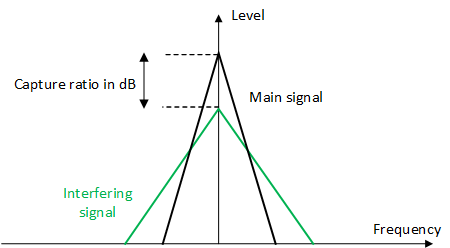FM capture effect
Introduction and definition
The capture effect is a phenomenon where the receiver sees two signals with similar frequency - but only the stronger signal is demodulated with moderate to complete suppression of the other. You can compare this to the usual case, where both signals enter the receiver and the combined signal is heard. It is known as the FM capture effect because this only happens when receiving signals that are frequency modulated.
The difference in strength between the stronger and weaker signal need not be very large for the phenomenon to occur which can result in intermittent reception between one signal and the other.
Example of the FM capture effect
An example is during a car journey where the radio is tuned to a station (A) but an interfering station at the same frequency (B) is also close by. Since the radio does not discriminate between the desired (A) and the interfering signal (B), it will only demodulate the one it sees as the strongest. This can cause intermittent reception between A and B, for example when the car is at equal distance d from both transmitters.

Capture effect in a car. At d, there is little difference in the signal level.
Why is this unique to FM?
We can explain this by looking at the differences between AM and FM receiving stages.

AM and FM demodulation
Demodulation differences between AM and FM
When we compare both processes, we can see that the FM receiver includes at least one amplifier that performs a limiting or limiter function. This is usually present at the last stage before demodulation.
The limiter
So what is a limiter?
Since detection for FM only needs to sense frequency variations and not amplitude, it makes sense to remove any amplitude variations that are not needed. This is especially true when small amplitude variations may interfere with the FM detection circuitry. The limiter circuit "flattens" the signal and removes any peaks before passing it to the demodulator stage.

FM signal after passing through limiter
How does this lead to the capture effect?
The limiter chops off any part of the waveform that passes its threshold leaving behind peaks that have "flat tops". Even if the limiter is driven to near saturation - as long as the zero crossings are still visible, FM demodulators can recover the original signal. Obviously this cannot be applied to AM as the information is carried in the amplitude variations so limiters are not used.
So what happens when the main signal meets a weaker interfering signal on the same carrier frequency?
Even though the carrier frequency is the same for both - unlike AM where the frequency is constant, the instantaneous frequency of both FM signals is not constant. Thus the interference from the weaker signal will look like noise to the main signal.

Through limiting, the noise from the interfering signal has been eliminated and the zero crossings of the main signal are still visible. Thus the main signal can still be demodulated.
Capture ratio
The capture ratio of a receiver is the gap (in dB) that must be kept between signals for the capture effect (or for the receiver to successfully "lock" on to one signal) to occur. For example in the diagram below, as long as the capture ratio is maintained between the main and interfering signals, the receiver will always suppress the interfering signal.

Capture ratio
Advantages and disadvantages of the capture effect
Lower co-channel interference
The presence of the FM capture effect means less impact from neighbouring stations that use similar frequencies. As long as the capture ratio is maintained then communication between the designated transmitter and receiver can take place without interference.
FM vs AM radio
While listening to the FM radio in the car under the influence of the capture effect, competing signals can cause the radio to jump from one broadcasting station to the other resulting in sudden loss of signal.
Since AM does not exhibit the capture effect, a stronger signal in the same area will overpower a weaker signal but the receiver will still allow both signals to be heard.
Why does air band use AM instead of FM?
Continuing on from above, communication between aircraft use AM due to the absence of the capture effect. This is because the pilots need to hear their transmissions as well as hear any weaker transmissions on the same channel. Since the capture effect only causes one signal to be heard, FM cannot be used here.
Relationship to the near-far effect
The near-far effect is a general description of what happens when a receiver tries to listen to a transmitter far away, but sees a much stronger signal from a closer transmitter on the same frequency. While every communication system experiences some degradation in the wanted signal, the capture effect is unique to FM only.
